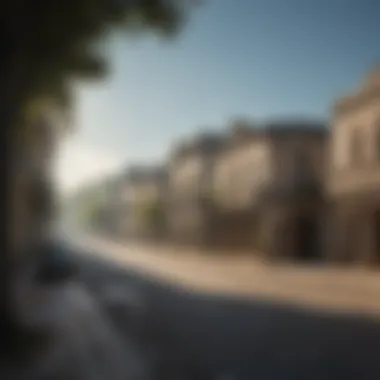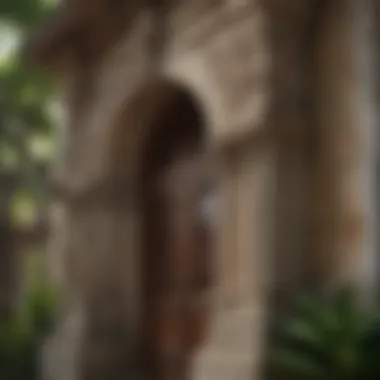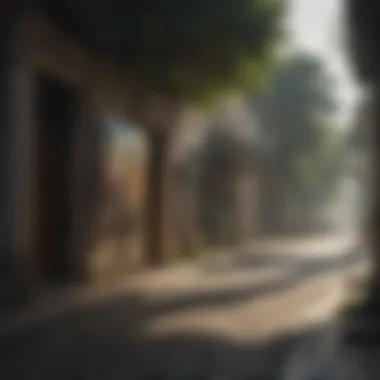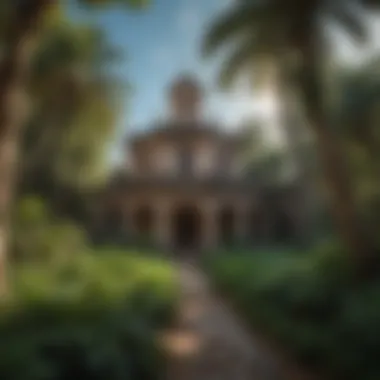Discovering the Rich Heritage of Ciudad Colonial Santo Domingo


Intro
Exploring the layers of history in Ciudad Colonial Santo Domingo offers a window into the past, showcasing a blend of culture and architecture shaped by centuries of colonization and local resistance. This district stands as a testament to the era that sculpted the soul of the Dominican Republic. Visitors can ponder over historical significances while marveling at contemporary local life around them.
The origins of this area are rooted deep in the early 16th century, marking the first European settlement in the Americas. The distinctive architectural highlights and the urban fabric tell stories of conquest, trade, and the evolution of society within these historic walls. Understanding this context enriches one's experience as it unveils the dynamic interplay between its storied past and the present.
As we proceed through the following sections, we will illuminate key aspects that define Ciudad Colonial, from its architectural legacy to its culture today. It is crucial to understand how these elements converge to form an invaluable part of Dominican heritage. Anyone interested in history and culture will find a wealth of information as we navigate these insights.
Prelims to Ciudad Colonial Santo Domingo
The Ciudad Colonial Santo Domingo holds immense historical and cultural value within the Dominican Republic. This area represents a treasure chest of architectural splendor and embodies the city’s rich colonial past. As one of the oldest cities in the New World, it serves as a testament to the blending of European and indigenous traditions. Understanding the foundation and characteristics of this site is crucial for appreciating its contemporary significance and ongoing influences.
Geographical Context
Ciudad Colonial Santo Domingo, located on the southern coast of the Dominican Republic, is bordered by the Caribbean Sea. This geographical positioning was strategic in the 16th century when it served as a pivotal point for Spanish expeditions and trade routes across the Americas. The area features a blend of urban spaces, open plazas, and streets that echo a colonial layout. The terrain also includes sights such as the Ozama River. These factors contribute to its cultural landscape, making it a unique destination for both tourists and academics wishing to explore historical influences in urban design.
Historical Significance
The foundation of Ciudad Colonial Santo Domingo dates back to 1496, making it a cornerstone in the context of the Age of Exploration. Significantly, it acted as the base for further conquest and colonization in the Americas. The historic district houses many of the first ecclesiastical and civil structures in the New World. For example, the St. Mary of the Incarnation Cathedral, completed in 1541, stands as one of the earliest cathedrals in the Americas. Moreover, the escape routes of enslaved people and other significant encounters mark the area with profound stories of struggle and resistance.
The Founding of Santo Domingo
The establishment of Santo Domingo holds immense importance in understanding the historical and cultural fabric of Ciudad Colonial. Founded in 1496, it marked the creation of the first permanent settlement in the New World by European powers. This event not only laid the foundations for the urban landscape of Santo Domingo but also showcased Spain’s expansion during the Age of Exploration. The city's founding symbolizes the beginnings of colonial governance and cultural exchange in the Americas, carrying implications that extend from architecture to the sociopolitical dynamics we see today.
Colonial Origins
The roots of Santo Domingo can be traced back to Christopher Columbus. During his first voyage in 1492, Columbus arrived on the shores of Hispaniola and laid claim to the land for Spain. The decision to establish a colony was made two years later, leading to the creation of Santo Domingo. The location was strategically chosen; positioned near the mouth of the Ozama River, it offered protection and accessibility across the Caribbean.
The settlement quickly came to symbolize Spanish rule in the region. Direct colonial administration began, introducing new societal structures that combined European methods with indigenous practices. European settlers engaged with the local Taino population, leading to a mixing of cultures, but it also set the stage for numerous conflicts and challenges raised by colonial policies. The implications were vast, altering both the land and the societies that inhabited it.
Key Figures in Establishment
The founding and development of Santo Domingo were facilitated by several pivotal figures. Among them was Bártoloemé Colón, the brother of Christopher Columbus. He played a key role in urban planning and governance during its early years. Diego Colón, another relative of Columbus, took on administrative responsibilities that laid additional groundwork for governance.
Mariano de Ocaña, a noteworthy figure, contributed to defense by developing fortress structures such as the Fortaleza Ozama, which became significant for protecting against piracy and invasions. These individuals not only shaped the early structure of Santo Domingo but represented broader European ambitions during the colonization period. Their actions, whether overt successes or failures, molded the lineage of one of the most historically rich sections of the Caribbean.
Architectural Highlights of Ciudad Colonial
Exploring the architectural highlights of Ciudad Colonial Santo Domingo provides a glimpse into the historical and cultural significance of the area. Its buildings tell stories of colonial powers, religious influences, and the evolution of urban design. The architecture reflects a unique blend of styles from various periods and preserves the traditions and heritage of the Dominican Republic.
Colonial Architecture Styles
The architectural styles found in Ciudad Colonial are a mix influenced by Spanish, Gothic, and Renaissance designs. Notable features are the thick stone walls, arches, and ornamental details that denote colonial power. In addition, wooden balconies adorn many buildings, providing character and elegance.
Key styles to note include:


- Gothic: Characterized by pointed arches, vaults, and intricate details typical of religious structures.
- Renaissance: Marked by a return to classical ideals, featuring symmetry and proportion in designs.
- Baroque: Known for its dramatic use of light and shadow with elaborate decorations, often visible in churches and public buildings.
Prominent Structures
Several iconic structures define the skyline of Ciudad Colonial and serve as testaments to its rich history. These include:
Alcázar de Colón
Alcázar de Colón, originally built over four centuries ago, stands out due to its designed elegance and historical importance. It served as a residence for Diego Columbus, son of Christopher Columbus. The unique characteristic of Alcázar de Colón is its blend of Gothic and Renaissance elements, evident both in its façade and interior layout.
This building is a beneficial choice for understanding the feudal systems of the colony and the power dynamics of its era. Its unique feature includes meticulously crafted ceilings and walls adorned with artwork depicting that period. However, the building faces challenges, including the need for continual preservation efforts to maintain its intricate decorations.
Catedral Primada de América
Catedral Primada de América is another magnificent structure that captures the essence of Colonial Santo Domingo. As the oldest cathedral in the Americas, it tells a profound story of faith and architectural progression. Its key characteristic is the combination of Gothic and Moorish styles, enhancing its artistic value.
This site represents historical importance not only to the Dominican Republic but also to Latin America. Its unique feature is the lavish altar and elaborately designed chapels that reflect deep religious sentiments. One of its disadvantages, however, is the complex surrounding street layout, which may disorient first-time visitors.
Fortaleza Ozama
Fortaleza Ozama is perhaps the most defensive structure remaining from the colonial era. Built to protect the city from invasions, it exudes strength and strategic significance. The key characteristic of this fortress is its imposing walls and round towers, making it excellent for exploration.
Its prior importance lies in its role as a military stronghold during numerous conflicts. Unique features include the citadel's views of the Ozama River. One disadvantage is its age-related deterioration, prompting ongoing restoration efforts to better serve the community and tourists.
The architectural highlights of Ciudad Colonial play a vital role in understanding its history and culture, thus enriching the overall experience of this striking area.
These structures not only represent architectural beauty but also serve as critical reminders of the Dominican Republic's past. They offer an educational lens into colonization, power, and faith.
Cultural Landscape of Ciudad Colonial
The cultural landscape of Ciudad Colonial is an intricate tapestry woven from centuries of history, traditions, and social interactions. Understanding this cultural backdrop adds depth to the appreciation of Santo Domingo's historical and architectural significance. It allows one to see how cultural practices have transformed throughout years while still honoring their roots.
Evolving Traditions
Traditions in Ciudad Colonial are not stagnant; they continuously adapt and progress with each passing generation. For example, local art forms reflect a unique combination of indigenous, African, and European influences. This dynamic mix can be observed in dance styles, citizenship ceremonies, and crafts, all contributing to the city's vibrant atmosphere.
As we consider traditional Dominican music, merengue and bachata stand out as key elements. Mention them in discussions about contemporary artistic practices because they symbolize cultural heritage while appealing to new audiences. The use of traditional materials in crafts like ceramics and paintings also continues, showing that while the traditions evolve, their essence remains.
The evolving traditions, alongside popular beliefs, serve as storytellers for a place rich in human experience and resilience. It binds the community as it paves the path toward modern interpretations of culture that still resonate with the past.
Festivals and Events
The festivals and events in Ciudad Colonial play a vital role in maintaining many local traditions and communal ties. Some prominent celebrations include the Annual Carnival, Santo Domingo Merengue Festival, and cultural nights at various plazas. Through these events, visitors experience the unfiltered expressions of local joy, creativity, and collective culture.
“Today’s celebrations encapsulate not just the festivities but the story of resilience and transformation Began generations ago.”
Aiming for a deeper understanding of these gatherings is crucial. They involve:


- Music and dance performances, embracing both elders and youth.
- Local cuisine put on display, promoting culinary traditions that offer taste with a back story.
- Community involvement through parades, which create a sense of belonging.
In summary, festivals and events enrich the cultural landscape of Ciudad Colonial. They showcase historical narratives and show how culture continues to be cultivated in this storied area. The future will likely see more adaptation, but their core will remain rooted firmly in the past, bridging generations with every celebration.
Impact of Tourism
Tourism plays a crucial role in shaping the ongoing narratives of Ciudad Colonial Santo Domingo. It acts as a bridge connecting the history-rich structures and modern-day activities of the city. The influx of visitors not only brings vitality but also emphasizes the need for preservation and sustainable practices. Understanding the tourism impact is critical for anyone looking to grasp the duality of significance this vibrant area holds.
Visitor Demographics
The visitor demographics reveal key insights into who is drawn to this historic district. Travelers from diverse backgrounds converge in Ciudad Colonial, seeking to explore its architectural beauty and cultural depth. Usually, these visitors include:
- Historians and scholars looking for in-depth study of colonial influence.
- Cultural enthusiasts interested in local music, dance, and art.
- Leisure travelers who want an immersive experience in rich traditions from the past.
According to tourism data, about 70 percent of the visitors come from North America, mainly the United States and Canada. However, European and South American tourists are increasingly engaging with this area due to its educational and cultural offerings. The varying interests within this demographic reflect in chosen activities, such as:
- Participation in guided tours highlighting history.
- Attending local festivals that celebrate culture.
- Shopping for artisanal crafts from local vendors.
These activities establish a connection with the local populace and enrich their tourism experience. Notably, each group contributes to an understanding of how global dynamics influence local heritage.
Economic Effects on Local Communities
Economic effects on local communities of Ciudad Colonial are substantial. Tourism not only invigorates the economy, but also opens doors for many businesses. Local shops, restaurants, and hotels thrive due to increased foot traffic influenced by tourist attractions. Key points include:
- Job Creation: Tourism creates employment opportunities in various sectors, such as hospitality and retail.
- Increased Revenue for Local Government: Higher visitor numbers lead to enhanced tax revenues, which can be utilized for community projects.
- Investment in Infrastructure: To accommodate visitors, infrastructure enhancement becomes essential. This results in better public services and facilities for both locals and tourists.
However, the economic effects are not solely positive. There are challenges that arise due to over-dependence on tourism revenues. Some small businesses may struggle against larger, corporate entities that dominate the market.
“Recognizing the balance between tourism's benefits and drawbacks is vital for long-term sustainability and community prosperity.”
In summary, the impact of tourism on Ciudad Colonial brings transformative benefits but requires careful consideration of the dynamics involved. Encouraging responsible tourism practices may help locals and visitors have a rewarding experience.
Conservation Efforts and Challenges
Conservation of Ciudad Colonial Santo Domingo is a vital topic that speaks to the balance of heritage preservation and modern development. Ensuring that the historical and cultural significance of this area is maintained is crucial. At the same time, local communities benefit from sustainable tourism and economic growth through conservation efforts. Thus, an encompassing view of the importance of these efforts reveals both legacy and contemporary application.
Historical Preservation Initiatives
A variety of initiatives aim to protect and enhance the architectural riches of Ciudad Colonial. Central to these efforts is the Dirección de Patrimonio Cultural. It works diligently to foster public awareness about the value of cultural heritage. Government and non-governmental organizations collaborate on projects for restoration and funding. Historically, institutions like UNESCO have played a significant role, designating the area as a World Heritage site in 1990.
Efforts include:
- Restoration of buildings such as Alcázar de Colón, which showcases Renaissance architecture.
- Programs to defend traditional artisanal practices that compliment the architectural history.
- Educational versus programs aimed at schools and communities to instill the value of heritage.
Such initiatives are not merely reactive. They strive for proactivity to stimulate local pride and ownership over cultural sites.


Modern Threats to Heritage
Ciudad Colonial faces various modern threats that challenge its preservation. Urban development pressures, pollution, and inadequate government funding are factors that contribute to the jeopardy of historical sites. Expanding infrastructure almost invariably targets historic zones.
Specific threats include:
- Water damage resulting from inefficient drainage systems continues to affect many old structures.
- Tourism over-saturation may lead to the gradual degradation of public areas.
- Lack of resources hampers the full enactment of conservation policies.
Underlying these challenges is the debate about what constitutes ‘progress.’ Inappropriate development may both obscure historical context and undermine the unique characteristics that make the Ciudad Colonial significantly important.
Preserving Ciudad Colonial Santo Domingo requires collective action and sustained conversation about its future in light of modern necessities.
Balancing these challenges with effective conservation strategies serves the goal of sustaining both natural and cultural heritage for future generations. Addressing these intricacies lays foundational ground for establishing effective plans, blending tradition and modern necessities harmoniously.
Connection to Contemporary Dominican Identity
Understanding the connection between Ciudad Colonial Santo Domingo and contemporary Dominican identity reveals the layers of heritage that inform current cultural practices. This section examines diverse aspects of identity shaped by history, ensuring the reader recognizes the lasting influence of the past on today’s society.
Legacy of Diversity
The legacy of diversity in Ciudad Colonial is a major component of its identity. From the influence of Taíno, African, and European cultures, the historical narrative suggests a rich tapestry. Each of these groups has contributed to the modernization of Dominican culture, evident in music, food, and festivals.
- Taíno influences can be seen in local agricultural practices and culinary traditions.
- African heritage manifests through music genres, like merengue and bachata, which explore themes of resilience and community.
- European architecture lends a traditional charm to the city, marking the colonial stylistic transitions.
With such a foundation, the characterization of contemporary Dominican identity now embodies respect for its roots while evolving toward inclusivity and unity. The fusion of varying traditions encourages a celebration of multiculturalism, giving rise to unique artistic expressions.
Role in National Consciousness
Santo Domingo's Ciudad Colonial plays a pivotal role in fostering national consciousness. This area is more than a historic site; it recognizes the Dominican Republic’s journey through time. Historical elements constantly remind residents and visitors alike of collective resilience and identity formation.
Culmination: The Future of Ciudad Colonial Santo Domingo
The future of Ciudad Colonial Santo Domingo holds significant importance given its unique blend of historical value and contemporary relevance. This section emphasizes the critical necessity of preserving the site’s rich heritage while acknowledging the challenges that modernization and urban development bring to the landscape. The interwoven narratives of the past and present fortify the area’s identity, allowing future generations to appreciate and learn from those who came before them.
Preserving the Past for Future Generations
To maintain the essence of Ciudad Colonial, efforts must focus on preserving the architectural identity and the stories that permeate its streets. This involves:
- Implementing strict regulations around construction and restructuring to ensure historical adherence.
- Involving local communities in decision-making processes regarding urban development initiatives and preserving local culture.
- Establishing partnerships with international heritage organizations to gain support and expertise in conservation efforts.
Organizations can also create educational institutions that specialize in the history and art of Colonial Dominican architecture. Moreover, fostering local artisans and workshops to pass on skills through generations can uphold traditions as a part of the modern identity of the area. The integration of advocacy strategies will empower local residents to speak for the preservation of their inherent historic context and prevent any threats from neglect or inappropriate development.
Potential for Sustainable Development
Sustainable development is essential for the future viability of Ciudad Colonial Santo Domingo. Balancing economic growth while safeguarding historical integrity involves several strategic considerations:
- Promoting eco-tourism that emphasizes cultural connections without introducing overwhelming commercial enterprise.
- Investing in green spaces and public realms that appreciate both history and contemporary urban needs, creating areas where culture and leisure seamlessly coexist.
- Encouraging sustainable business practices within local industries, which can yield both economic benefits and minimizes ecological impacts.
Additionally, integrating sustainable transport options to lessen the environmental footprint can enhance the tourist experience while preserving its charm. The key to sustainable development in Ciudad Colonial lies in prioritizing environmental ethics alongside historical conservation.
Preserving Ciudad Colonial is an exercise in respecting the past while preparing for future opportunities. The synthesis of historical reverence and progressive practices can lead to thriving cultural heritage tourism and community unity.
In summation, the future of Ciudad Colonial Santo Domingo is intertwined with its ability to harness its past as a resource for a sustainable tomorrow. Acknowledge the uniqueness of its architectural styles and cultural heritage will create a foundation for long-lasting prosperity and ensure that future generations remain connected to their rich, historical roots.



